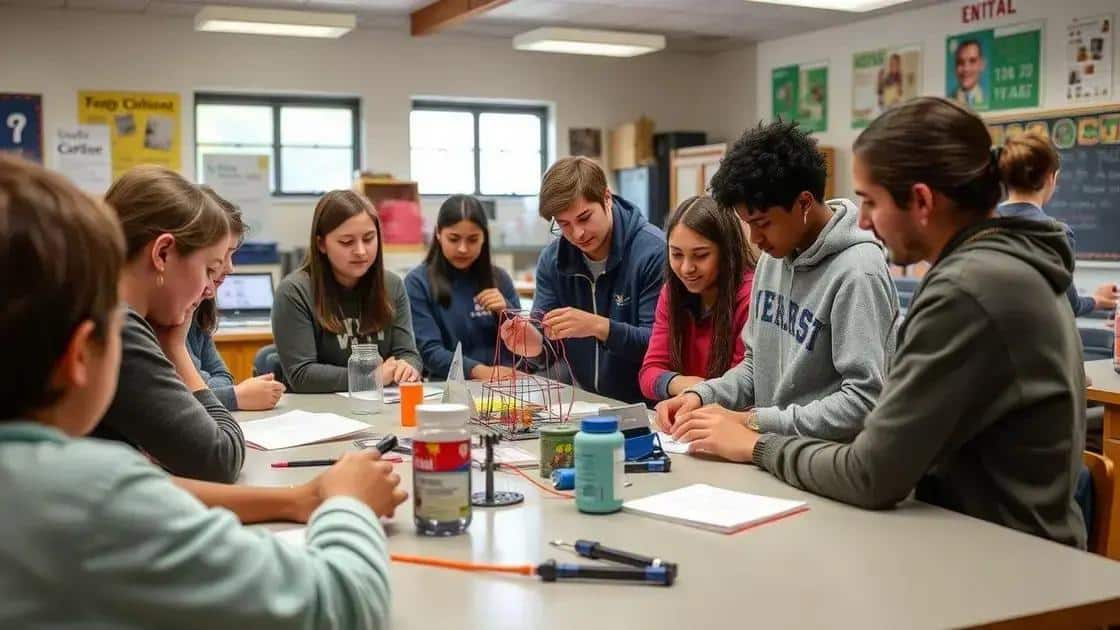STEM program access in rural high schools: bridging the gap

STEM program access in rural high schools is essential for empowering students with critical skills, fostering innovation, and bridging educational gaps through community involvement and technology integration.
STEM program access in rural high schools plays a vital role in shaping the futures of students. Have you ever wondered how young minds in these areas can thrive similar to their urban counterparts? In this article, we will explore the importance of these programs and their transformative potential.
The significance of STEM education in rural areas
STEM education is essential for rural schools. It helps students develop skills that are in high demand. In rural areas, where opportunities may be limited, these programs can open doors for students, allowing them to explore new interests and careers.
Why is STEM Education Important?
STEM education equips students with critical thinking and problem-solving skills. These abilities are valuable not just in science and math, but across all subjects. When students engage with projects in science, technology, engineering, and math, they learn to approach challenges with a creative mindset.
Benefits for Rural Communities
Implementing strong STEM programs can lead to several advantages:
- Increased job opportunities: Students gain skills that can help them find jobs in growing fields.
- Empowerment: Learning STEM subjects gives students confidence and a sense of achievement.
- Community development: As education improves, entire communities benefit from a more skilled workforce.
Moreover, when students participate in hands-on STEM projects, they often discover new interests. This can lead to higher engagement in school and reduce dropout rates. Schools that emphasize STEM also tend to foster a culture of innovation.
As we look to the future, ensuring that rural high schools have the resources for quality STEM education is crucial. Investing in these programs not only supports individual students but strengthens the entire community.
Challenges faced by rural high schools
Rural high schools often face significant challenges that can hinder the access to quality education. These difficulties can affect students’ futures and the community as a whole. Understanding these challenges is crucial for developing solutions.
Limited Resources
Many rural schools struggle with inadequate funding. They may lack the most basic supplies, such as updated textbooks or technology. This can lead to a learning environment that falls short of what urban schools typically offer.
- Insufficient technology: Many rural students have limited access to computers and the internet.
- Small staff: Rural schools might not have enough teachers, leading to larger class sizes.
- Outdated materials: Textbooks and teaching materials can be old and not meet current educational standards.
In addition to funding issues, rural high schools often find it challenging to attract and retain qualified teachers. Many educators prefer to work in urban areas, where salaries are higher and opportunities for professional development are more plentiful. This can leave rural students with less experienced teachers.
Transportation Difficulties
Transportation is another significant issue. Many students live far from their schools, making it hard for them to get to class every day. This results in high absentee rates, affecting their overall academic performance and engagement.
On top of this, rural areas may lack extracurricular programs that are essential for a well-rounded education. Limited access to science labs, art programs, and sports can make school less appealing to students, leading to lower enrollment rates.
In summary, addressing the challenges faced by rural high schools is vital. It is necessary to ensure that students receive the same quality of education that their urban peers do. Investments in resources, teacher support, and transportation solutions can create positive changes.
Successful STEM program initiatives

Many rural high schools have started implementing successful STEM program initiatives to improve student engagement and learning outcomes. These programs are tailored to meet the unique needs of students in rural areas.
Project-Based Learning
One effective approach is project-based learning. In this method, students work on real-world problems. They learn by creating projects that require the application of science, technology, engineering, and math. This hands-on learning not only engages students but also helps them understand the relevance of their education.
- Example projects: Constructing solar-powered devices or building simple robots.
- Collaboration: Students often work in teams, building communication and teamwork skills.
- Mentorship: Involving local professionals can enhance learning experiences.
In addition to project-based learning, many schools foster partnerships with local businesses and organizations. These collaborations can provide resources, expertise, and funding. Such partnerships often lead to internship opportunities for students, enhancing their real-world experience.
Community Involvement
Community involvement is also crucial for the success of STEM programs. By engaging parents and local organizations, schools can create supportive networks. Community members can serve as volunteers, guest speakers, and mentors, offering students guidance and encouragement.
Moreover, schools often host events like science fairs and STEM expos. These events showcase student projects and promote interest in STEM fields within the community. They allow students to present their work, boosting their confidence and communication skills.
In summary, successful STEM initiatives in rural high schools can significantly impact students’ educational experiences. By focusing on project-based learning, community involvement, and partnerships, these schools can inspire the next generation of scientists, engineers, and innovators.
Community involvement in promoting STEM access
Community involvement plays a vital role in promoting STEM access in rural high schools. When local residents participate, they help create a supportive environment that encourages students’ interest in science, technology, engineering, and math.
Building Partnerships
One effective way to promote STEM education is through partnerships between schools and local organizations. Businesses, nonprofits, and universities can collaborate with schools to provide resources and mentorship. These partnerships allow students to gain real-world insights and experiences, enhancing their education.
- Mentorship programs: Local professionals can guide students through projects and career exploration.
- Sponsorship: Businesses may offer funding for equipment and materials, helping to build robust STEM programs.
- Job shadowing: Students can learn about various careers through firsthand experience with local industries.
Involving community members not only enriches the learning experience but also fosters a sense of belonging. Students feel valued when they see adults in their community taking an interest in their education.
Organizing Events
Community events, such as science fairs and STEM festivals, are excellent opportunities to promote STEM. These gatherings can showcase student work and celebrate achievements in science and technology. They also draw attention to the importance of STEM fields.
Such events allow families and community members to engage with students’ education. Having local scientists, engineers, and tech professionals present can inspire students to pursue these fields. When students interact with role models, it can ignite their passion for learning.
Additionally, schools may offer workshops that invite parents to learn alongside their children. This collaboration encourages families to engage with STEM topics at home, creating a culture of scientific inquiry.
Future of STEM education in rural communities
The future of STEM education in rural communities looks promising. With the right initiatives, these areas can thrive by providing students with strong science, technology, engineering, and math skills. As technology continues to advance, it’s vital for rural schools to adapt and innovate.
Integrating Technology in Learning
One way to enhance STEM education is through the integration of technology in the classroom. This includes using digital tools that allow for interactive learning experiences. Virtual labs, online simulations, and educational software can help students grasp complex concepts.
- Online resources: Access to various online portals can expand learning opportunities beyond textbooks.
- Mobile learning: Utilizing smartphones and tablets can make learning more accessible.
- Collaboration tools: Platforms that facilitate group work can boost teamwork skills.
As students engage with technology, they become more prepared for modern careers. It’s essential that schools provide training not just for students, but for teachers as well, ensuring they are equipped to guide students through these new tools.
Community Collaboration
The future also hinges on continued collaboration with local businesses and organizations. Schools can form partnerships that offer internships and real-world projects. This type of engagement connects students to their community and helps them understand the importance of STEM in everyday life.
Moreover, encouraging community involvement ensures that educational programs remain relevant to local needs. For instance, local businesses might have specific scientific or technical skills they require. By aligning education with these needs, students are more likely to secure jobs after graduation.
Investing in STEM education in rural areas holds the potential to change lives and uplift entire communities. By fostering innovation and collaboration, schools can create environments where students are excited about learning and prepared for the future.
FAQ – Frequently Asked Questions about STEM Education in Rural Communities
Why is STEM education important in rural areas?
STEM education prepares students for high-demand careers and helps bridge the gap between urban and rural opportunities.
How can communities support STEM programs in schools?
Communities can support STEM programs by forming partnerships with schools, providing mentorship, and sponsoring events.
What role does technology play in STEM education?
Technology enhances learning through interactive experiences, allowing students to engage with complex concepts using digital tools.
How can parents get involved in their children’s STEM education?
Parents can get involved by attending STEM events, volunteering at schools, and encouraging their children to explore science and technology at home.





